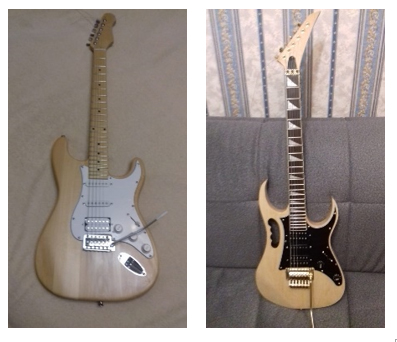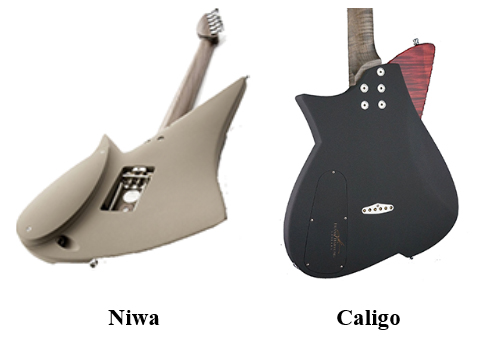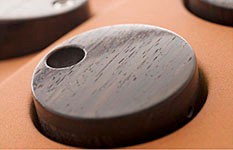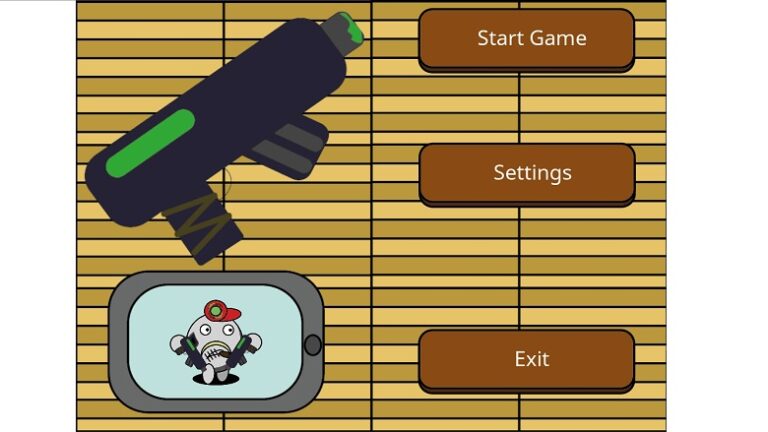Making a NiGo guitar
Instead of a preface
I must say right away that this material is unlikely to be of interest to venerable guitar masters, unless there is a desire to express their opinion and teach the author’s mind, for which, however, I will be very grateful.
I was about to make my third electric guitar. Before her, classic copies were made: Fender Stratocaster and Ibanez JEM 777.

I really wanted to get away from the classics and make a guitar in an unusual, modern style.

After a long search, 2 models attracted attention: NIWA Ulrich Teuffel (Ulrich Teuffel) And caligo Frank Hartung (Frank Hartung). Both models impressed me a lot.


In my opinion, the styles of Niwa and Caligo are very similar. The design of Niwa and Caligo is very modern, I would even say futuristic, and consciously does not rely on the usual classics of electric guitars. Frank Hartung created his guitar a little later than Ulrich Teuffel’s masterpiece, which suggested that Hartung was at least familiar with Teuffel’s work, and at most used some of his “false” ideas. Indeed, later in one of the interviews I read that Hartung partially studied at the works of Ulrich Teuffel.
In one of the articles I read: “If Ulrich Teuffel lived in the Middle Ages, and if guitarists were as passionate about their views and traditions as they are now, then most likely the German designer would have been burned at the stake.”
Niwa and Caligo both have their pros and cons in terms of their replayability:
in my opinion, the design of Niwa is much more interesting, but the geometry of the case is very complex and, as a result, the technology is more complicated and much more wood is required for the manufacture of the case (the declared thickness of Niwa is 90 mm);
on the other hand, the Caligo headstock is, in my opinion, much more interesting than the Niwa:

It is worth noting that Caligo (from Latin – “gloomy”) – a genus of butterflies, including more than two dozen species that live in the tropics and subtropics of the American continent – from Mexico to Argentina and Peru.
Obviously, the head of the Hartung vulture is stylized very much like a butterfly of the Caligo species.
Teuffel’s official website indicates the dimensions (length, width, thickness) of the Niwa guitar, but this data could not be found on the Hartung official website (and in general on the Internet); only the length of the scale is known – 655 mm and the number of frets – 22.
As a result of taking these factors into account, the idea of creating a hybrid electric guitar between Niwa and Caligo was born, which would incorporate all the most interesting and, if possible, implementable of these models for a beginner (which I consider myself to be). The name of the project was born immediately: Niwa + Caligo = NiGo.
It’s curious that Nigo is the nickname of Tomoaki Nagao, a well-known designer of the BAPE clothing brand in America and Japan (for 20 years), who has worked closely with Uniqlo, with the adidas Originals sneaker manufacturer, founder of the Billionaire Boys Club, member of the Teriyaki Boyz group and just an idea generator who regularly collaborates with singers Pharrell Williams and Kanye West.
Part 1: Designing the NiGo Deck
The first question that came up was: how similar are the geometry and dimensions of Niwa and Caligo? Geometry, purely visually, yes, but what about dimensions? I decided to “start off” from the known dimensions of the Caligo scale.
The scale length of an electric guitar is the distance from the nut to the bridge. In our case – 655 mm.

With the help of any program for calculating the scale, for example, Fret position calculatorcalculate the distance from the nut to the 22nd fret.

A note for the future. For 655.000 mm scale, as a rule, Tune-o-matic style bridges are used, the size of the bridge’s sustain block directly affects the choice of guitar body thickness.
Thus, with our initial data, the distance from the nut to the 22nd fret is 471.197 mm. Let’s remember this distance.

Therefore, the distance from the 22nd fret to the bridge: 655 – 471.197 = 183.803 mm.
The largest and most frontal image of Caligo was found, loaded into Photoshop and cropped at the edges of the case.

By measuring the dimensions of the image in Photoshop, we got:
length – 287.16 mm
width – 233.89 mm
Let’s measure the distance from the image in Photoshop between the 22nd fret and the bridge. To do this, cut it out and take photoshop readings.

The distance between the nut and the bridge should be 183.803 mm, and on the image in Photoshop we got 124.18 mm. Thus, the image magnification factor in Photoshop (zoom factor) is 183.803 / 124.18 = 1.48.
We scale the Photoshop image, for example, in width 233.89 x 1.48 = 346.14 mm. Save the image in PDF format. Opening a PDF file with Adobe Acrobat Rider.

Select the

In the window that opens, select the Measurement tool, for example, “Snap type. Binding to Endpoints.
To control the correctness of scaling, let’s measure the distance from the 22nd fret to the bridge.

It turned out 180.54 mm. Analytical calculations showed 183.803. It seems that 183.803 – 180.54 = 3.263 mm is quite an acceptable result, and you can move on to measuring the length and width of the case.
Measured body width – 345.22 mm., Length – 423.83 mm.
Rounding up, take 345 x 425 mm. All other necessary “geometry” for the manufacture of the body template is measured in the same way.
Remarks
Martin Koch in his famous book writes that the approximate dimensions of the body are 320 mm wide at the widest part and about 400 mm long to the end of the neck heel.
Interestingly, the dimensions of Niwa, stated in the technical documentation, 340 x 450 mm., i.e. pretty much match the dimensions of the Caligo case.
For the basis of our guitar template NiGo choose the Caligo geometry: 340 x 425 mm.
Let’s print the finished template as a Poster at 100% scale.

Let’s cut out the contour of the template and stick it on the blank of the future guitar in order to cut the body along its contour using available means. Since I do everything at home and do not have the opportunity to use a full-fledged milling machine, I make and process the body using a jigsaw, renovator, Dremel, files, shavings, cycles, skins, etc. Perhaps I’m wrong, but due to the above conditions, the preliminary manufacture of a soundboard template, for example, from chipboard, makes sense if you plan to put the production of the guitar “on stream”.
The question remains as to how thick the body of the guitar is. There are quite a few parameters that affect the choice of thickness.
The minimum thickness of the soundboard depends on the electronics installed on the guitar, the thickness of the material required for fastening the neck, on the size of the sustain block of the tremolo system used (popularly “there-sudator”), unless, of course, you plan to install a fixed bridge. This thesis does not require explanations, just look at the picture below.

In addition, according to recognized authorities, a body less than 40 mm thick makes the guitar less attractive.
I really wanted to use the authority and experience of Teuffel, so Gotoh VG 300 (Japan) and Sure Claw spring tension mechanism from Schaller (Germany) were chosen as a tremolo system.

The depth of the sustain block is 41 mm, the dimensions of the Sure Claw mechanism are 52 x 42 x 14 mm. Thus, a case thickness of 45 mm should suffice.
The Sure Claw mechanism from the Schaller company (Germany) is a device for tensioning the springs of the tremolo system. Thanks to the Schaller Tremolo Shure Claw system, setting and tensioning the springs can be done in seconds with a hex wrench. The kit comes with a special tool (core), with which you can outline where to drill holes in the lid. System advantages:
the amplitude of the tension of the springs is greater: where the standard plank would already rest against the tree, Sure Claw allows you to tighten the springs further;
high gear ratio of the worm gear allows you to very quickly and accurately tune the tremolo;
light weight.
Sure Claw was bought on the site shamray.ru for 3760 rubles. It is interesting to note that almost 100% of the suppliers of this equipment indicated exactly this price (this is what a competent pricing policy of an exclusive distributor means!).
To sum up the design of NiGo:
body length – 425 mm;
body width – 340 mm;
case thickness – 45 mm.
design (approximate):

The knobs for the sound, tone and switch potentiometers are still planned to be made of wood:

Fasteners: stainless steel / chrome.
As a mode switch, it is planned to use a push / pull system (push-pull) designed to cut off one of the humbucker coils when the handle is pulled out, turning the humbucker into a single-pickup. The potentiometer can be used with any type of humbucking pickup. It can be installed on electric guitars with active and passive electronics.

As you can see, the selected thickness of the guitar will allow you to place the potentiometer in the case.
Body material selection
Since the trend for “exotic” was determined, I decided to follow this trend when choosing a material.
Here’s the tree that got me excited.

This is Makore (Africa) – one of the most beautiful exotic woods that can be found on the Russian market.
The tree is somewhat similar to the red, mahogany tree of small-layered varieties. The color of the wood varies from pinkish to blood red or reddish brown. The texture is much finer than mahogany. The wood is denser, harder and heavier.
The surface is glossy.
Details about this and other types of wood can be found on the website “Tree Species of the World”.
Finding a wide enough board for a deck is quite problematic, especially Makore. In most cases, the deck is glued in two parts.
As before, I ordered a Makore form for solid cases on the website MusicWood.ru – online store – workshop for the manufacture and sale of blanks from valuable wood for the production of guitars:


This is how I received the order through the company SDEK.

It is pleasant to note that the set price strictly corresponded to the results of the preliminary calculations of the calculator on the MusicWood.ru website.
The quality, as before, is excellent: the combination of wood texture is excellent, the two halves of the soundboard are fitted so that the gluing point is almost invisible. Very satisfied! Not to mention a gift – a Makore die, which I plan to use to decorate individual elements of the case, as well as (possibly) to make knobs for potentiometers and a switch.
Having carefully examined the photo of Caligo, I came to the conclusion that the upper fang is neatly cut into the body of the guitar (this is difficult in terms of technology, but, most likely, I’m not mistaken):

To do this at home, without special equipment, it seems to me, is quite difficult. Therefore, I decided to make a “trick”: a curly canine overlay on top and a corresponding selection from below.
Since I received a Makore die as a gift, before sculpting the soundboard, I decided to first make an overlay of the upper canine in order to understand what the material was unfamiliar to me in processing.

And here I am ready to report two pieces of news, as usual, good and bad:
bad – it looks like I got a “piece of metal”: the structure of the tree is so hard and complex in processing;
good: how “vociferously” the Makore tree sounds when tapped; Let’s see what happens in the final!
Part 2. Making the NiGo deck (to be continued)…
Briefly about the author
Shvyrkin Igor Nikolaevich, born in 1955, Colonel of the Reserve, two higher educations (Academy of the Strategic Missile Forces named after F.E. Dzerzhinsky, Moscow State University named after M.V. Lomonosov), Candidate of Technical Sciences.




